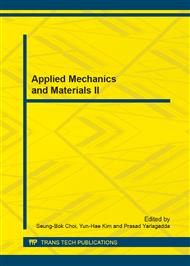p.524
p.531
p.535
p.539
p.543
p.547
p.553
p.558
p.562
Simulation and Optimization on GFRP Soil Nailing Support
Abstract:
Glass Fiber Reinforced Polymer (GFRP) soil nailing is great different from steel bar soil nailing in mechanical parameters and the properties. According to a excavation engineering supported by soil nailing, the support structure of soil nailing was simulated by finite element method. By analyzing the displacement, the force, the plastic area and other aspects in sensitive position, the results show that two types of soil nailing can ensure the stability of the slope under the same arrangement. The maximum displacement of GFRP soil nailing on control points of the slope is more 7% to 10% than steel bar soil nailings. Plastic zone of GFRP soil nailing support structures are more obvious in the range and the extent. The arrangement of GFRP soil nailing had been optimized by finite element software, the distance 1.6~1.8m between soil nailings is more appropriate for support structure.
Info:
Periodical:
Pages:
543-546
Citation:
Online since:
December 2013
Authors:
Price:
Сopyright:
© 2014 Trans Tech Publications Ltd. All Rights Reserved
Share:
Citation:


